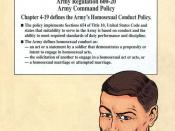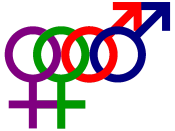Gay and Lesbian Youth
Introduction
Living in fear. That is the statement of 65% of gay and lesbian adolescents today. Attending high school as a gay or lesbian is like going to war. There is always the possibility of physical and mental abuse. Not only do these teens have to endure abuse at school, they also need to deal with abuse at home. According to statistics reported by Remafedi (1987), 50% of gay/lesbian teens reported rejection and abuse by family. Being a teenager whether gay or straight is a confusing time. In most respects youths with same-sex attractions are similar to all youths, independent of sexual desire. That is, an adolescent is an adolescent. Regardless of sexual orientation youths need the love and respect of parents, must negotiate their on-going relationship as they move toward adulthood, are concerned with peer status, desire love and sex, and wonder about their future.
These are adolescent tasks that, although affected by sexual orientation, are confronted by all youths (R.C. Savin-Williams, 2001). The need of feeling accepted is overwhelming. There are often moments of despair, however most teenagers find ways of coping with stress. Peer and parental support is key to developing healthy coping methods. Gay and lesbian adolescents don't always have those support venues. They often resort to substance abuse, and in extreme cases, suicide. Unfortunately, according to Shifrin & Solis (1992), the use of illicit drugs is a main factor implicated in the suicide attempts among gay and lesbian youth. The following paper will discuss the various stressors in a gay or lesbian adolescent's life.
It will also address substance abuse and suicidal tendencies. Homosexual adolescents are more likely to suffer from mental and physical health problems. This theory will be supported in the following paper.
Stressors Associated with Gay/Lesbian Youth
Getting up in the morning, getting dressed, and going to school is the life for millions of teenagers in North America. Although this routine is standard for high school students, gay and lesbian adolescents are often dealing with so many more issues than their heterosexual peers. The simple task of going to school can become a horrendously stressful event. Lesbian, and gay adolescents face tremendous challenges to growing up physically and mentally healthy in a culture that is almost uniformly anti-homosexual. Often, these youth face an increased risk of medical and psychosocial problems, caused not by their sexual orientation, but by society's extremely negative reaction to it. Gay and lesbian youth face rejection, isolation, verbal harassment and physical violence at home, in school, and in religious institutions. Gay and lesbian adolescents experience unique stressors in their lives that are directly related to their sexual behavior and identity (Savin-Williams, 1994). For example, the major problems reported by 60 gay and lesbian youths ages 16 to 22 years, were their perceived need to keep their homosexuality a secret and their belief that they were rejected by mainstream society because of their sexual behavior and identity (Roesler & Deisher, 1972, cited in Savin-Williams, 1994).
According to Rotheram-Borus, Rosario, and Koopman (1991), gay and lesbian youths often feel vulnerable because of "issues of disclosing or being discovered by family or friends, reactions by others to their homosexuality, and chronic stress associated with their homosexuality." Their empirical investigation, conducted with African-American and Hispanic gay and lesbian youths, reported that the most stressful events the youths faced were "coming out" to others, having their sexual orientation discovered by others, and being ridiculed because of their homosexuality. The youths felt that they had little or no control over the reactions of others.
Another major stressor for gay/lesbian adolescents is verbal and physical abuse. Significant numbers of lesbian, and gay youths report that they have been verbally and physically assaulted, robbed, raped, or sexually abused by family members and peers (National Gay and Lesbian Task Force, 1982). D'Augelli, 1992, conducted a study on violence inflicted on gay men and lesbians on college campuses, and the study revealed that 55% to 72% of those sampled reported verbal or physical abuse. The incidence of physical threats of violence reached 25% in several surveys. The most frequent abusers (64%) in D'Augelli's sample of 160 college lesbians and gay men were fellow students and roommates. In 23% of reported incidents, the abusers were faculty, staff, and administrators. Abuse within peer groups was also studied by D'Augelli in 1991. Over one half of the gay male adolescents reported being ridiculed because of their sexuality. Most abused were youths who failed to incorporate cultural ideals of gender-appropriate behaviors and roles.
This was also supported by a study conducted by Remafedi (1987), who found that 30% of gay male youths were victims of physical assaults, one half of which occurred on school property. Over one half reported regular verbal abuse from classmates, and 40% had lost a friend because of their homosexuality (Remafedi 1987, cited in Savin-Williams, 1994).
Sear's (1991), found that 97% of the 36 lesbian youth studied, recalled negative attitudes by classmates and over one half feared being harassed, especially if they came out in high school. Only two found a peer group that was supportive of lesbian and gay people. Therefore in Sear's (1991) study, most of the lesbians passed as heterosexual until graduation. In all of the studies mentioned it was found that lesbian and gay male youth avoided situations and people that might implicate them as being lesbian or gay. Very few reported harassment to the authorities, and nearly all expected to be harassed in the future. The ability to attend school without harassment should be a universal right, however as proven with the previous research, this is obviously not so. A sad thing about all of this abuse is that it often leaves the youth feeling isolated and depressed (Rotheram-Borus, Rosario, Rossem, Reid, & Gillis, 1995). The feelings of not being accepted may cause the adolescent to begin viewing suicide as a way to resolve the pain.
Suicidal Tendencies among Gay/Lesbian Youth
Suicide is the third leading cause of adolescent mortality in the United States, accounting for nearly 5,000 (13.3%) of the 37,000 annual deaths in the 15 - 24 year old age category (National Center for Health Statistics, 1993).
The rate of youth suicide has increased by more than 200% since 1960, whereas the rate of suicide in the general population has risen by 17% (National Center for Health Statistics, 1986). The current estimated lifetime prevalence of suicide attempts among adolescents ranges from 1.3% to 10% (Warwick, Aggleton, & Douglas, 2001). According to Warwick et al. (2001), about 10% of unsuccessful adolescent suicide attempters die in a subsequent attempt. Among adolescents, lesbian and gay youth have been identified as being at an elevated risk for suicide (Savin-Williams, 1994). Studies of suicide attempts have found that up to 40% of the lesbian and gay youth studied have made an attempt (D'Augelli & Hershberger, 1993; Hammelman, 1993; Herdt, & Boxer, 1993; Martin, & Hetrick, 1988; Remafedi, 1987; Remafedi, Farrow, & Deisher, 1991; Rotheram-Borus, Hunter, & Rosario, 1994; Schneider, Farberow, & Kruks, 1989, as cited in Hershberger, & Pilkington, 1997). This finding is considerably higher than the rate of suicide attempts among adolescents in general, which ranges from 6% to 13% (Hershberger, & Pilkington, 1997). Research on suicide attempts among lesbian and gay youth indicates risk factors similar to those found among all adolescent suicide attempters. Among such factors are low self-esteem, difficulties in romantic relationships, family discord, a history of attempted or completed suicides among family and/or friends, physical abuse, and substance abuse (Garland, & Zigler, 1993, as cited in Hershberger, & Pilkington, 1997). In addition to factors common to all youth contemplating suicide, gay and lesbian youth must deal with the unique stressors that put that increase their suicide risk (Bagley, & D'Augelli, 2000).
Hershberger et al., (1997), conducted a study on the predictors of gay and lesbian adolescent suicide. It was found that 40% of the sample (sample size of 194) reported at least one suicide attempt (40% of the males, and 43% of the females). The number of past attempts ranged from 1 through to 15. Of the youth who made an attempt, multiple-occasion attempters were somewhat more common (23% of the total sample) than were single-occasion attempters (17%). The attempt used most often was drug overdose, used by 70% of those attempting suicide. In 2001, Savin-Williams had similar finding. This researcher found that homosexual youth (both gay and lesbian), were twice as likely as heterosexual women and ten times more likely than heterosexual men to report a suicide attempt. Savin-Williams (2001), also concluded that sexual-minority youths report higher rates of suicide attempts than do heterosexual youths. These finding directly support the current paper's thesis. As was stated earlier, Garland et al, (1993), found that substance abuse was a factor in suicide attempts among gay and lesbian adolescents, and Hershberger et al., (1997), reported that the most common method of attempting suicide was drug overdose. It has been proven through the analyzation of the documented research that substance abuse, is prevalent in the lives of homosexual adolescents.
Substance Abuse among Gay and Lesbian Adolescents
Substance abuse is a critical problem among all youths in the United States. Among the groups believed to be at the highest risk are those with same-sex sexual orientation (Russell, Driscoll, & Truong, 2002). Russell et al., (2002), conducted a study using 20,000 adolescents in grades 7 through to 12. Of the sample studied, 26% of the males, and 12% of the females, defined themselves as homosexual.
The researches questioned all of the participants about their use of marijuana, and alcohol. According to Russell et al., (2002), 86% of homosexual males reported using marijuana compared to 73% of heterosexual males, and 76% of homosexual females reported using marijuana, compared to 46% of heterosexual females. When it came to alcohol use, 83% of homosexual males reported drinking alcohol, compared to 81% of heterosexual males, and 79% of homosexual females reported drinking alcohol, compared to 76% of heterosexual females. These finding show a correlation between homosexuality and substance abuse. Another study that researched the prevalence of substance abuse among gay adolescents was conducted by Rotheram-Borus, Rosario, Rossem, Reid, and Gillis, (1995). Rotheram-Borus et al., (1995) recruited 141 male adolescents between the ages of 14 and 19 years of age (some of the participants required informed consent). The researchers questioned the youth on drug and alcohol use. In the 3 months preceding the study, 63% had used alcohol, and 33% marijuana. Of the sample, 43% reported using alcohol on a less than weekly basis, whereas 26% used alcohol one or more times per week. For drug use, the respective numbers are 23% and 13%. Substantial numbers of the adolescents reported bad reactions that are due to substance use (28%), as well as health problems (12%). These finding are extremely disturbing. Not only are homosexual youths dealing with feelings of depression and alienation, they are according to the research, resorting to illegal drug use, and alcohol more often than their heterosexual peers
Conclusion
As has been discussed in the current paper, gay and lesbian youth face extreme challenges in the pursuit for the ultimate goal, acceptance. Although a lot of gay and lesbian adolescents find themselves turning to substance abuse, or suicide as a method of resolving the stress in their lives, there are an abundance of support venues waiting to be discovered. Some of these include the Pride Institute, the Hetrick-Martin Institute, the Broward Gay and Lesbian Youth Group, the Coral Springs Youth Group, the Coming Out Group, Pride Line Youth Services and GLOW (Gay and Lesbians Offering Warmth). Growing up is a demanding and challenging task for every adolescent. One important aspect is forming one's sexual identity. All children explore and experiment sexually as part of normal development. This sexual behavior may be with members of the same or opposite sex. For many adolescents, thinking about and/or experimenting with the same sex may cause concerns and anxiety regarding their sexual orientation. For others, even thoughts or fantasies may cause anxiety (Diamond, 2000). According to Diamond (2000), homosexuality is the persistent sexual and emotional attraction to someone of the same sex. It is part of the range of sexual expression. Many gay and lesbian individuals first become aware of and experience their homosexual thoughts and feelings during childhood and adolescence. Homosexuality has existed throughout history and across cultures (Savin-Williams, 2001). Recent changes in society's attitude toward homosexuality have helped some gay and lesbian teens feel more comfortable with their sexual orientation.
In other aspects of their development, they are similar to heterosexual youngsters. They experience the same kinds of stress, struggles, and tasks during adolescence.
According to Diamond (2000), parents and peers need to clearly understand that homosexual orientation is not a mental disorder. The cause(s) of homosexuality are not fully understood. However, a person's sexual orientation is not a matter of choice. In other words, individuals have no more choice about being homosexual than heterosexual. All teenagers do have a choice about their expression of sexual behaviors and lifestyle, regardless of their sexual orientation.
As has been discussed in the current paper, gay and lesbian teens can become socially isolated, withdraw from activities and friends, develop depression, abuse drugs and alcohol, and contemplate suicide. Parents and peers need to be alert to these signs of distress because the studies documented that gay/lesbian youth account for a significant number of deaths by suicide in adolescence.
According to Diamond (2000), Savin-Williams (2001), and Russell et al. (2002), 10% of the population is gay, lesbian, bisexual, or transgender. These people could be our neighbors, our physicians, our friends, or even our family. If violence against minority groups could be banished, these adolescents that are struggling with their sexual identity would feel more accepted regardless of whom they choose to love. Perhaps they may also not feel the need to resort to substance abuse, or suicide if society could only learn to see past the negativity.
References
Bagley, C., & D'Augelli, A.R. (2000). Suicidal Behavior in gay, lesbian and bisexual youth. British Medical Journal, 320, 1617-1620.
D'Augelli, A.R. (1991). Gay men in College: Identity processes and adaptations. Journal of College Student Development, 32, 140-146.
D'Augelli, A.R. (1992). Lesbian and Gay male undergraduate's Experiences of Harassment and fear on campus. Journal of Interpersonal Violence, 7, 383-395.
Diamond, L.M. (2000). Sexual Identity, Attractions, and Behavior Among Sexual-Minority Women over a 2-Year Period. Developmental Psychology, 36, 241-250.
Hershberger, S.L., & D'Augelli, A.R. (1995). The Impact of Victimization on the Mental Health and Suicidality of Lesbian, Gay, and Bisexual Youths. Developmental Psychology, 31, 65-74.
Hershberger, S.L., & Pilkington, N.W. (1997). Predictors of suicide attempts among gay, lesbian, and bisexual youth. Journal of Adolescent Research, 12, 477-498.
Rotheram-Borus, M.J., Rosario, M., & Koopman,C. (1991). Minority Youths at high risk: Gay males and runaways. (in M.E. Colten & S. Gore (Eds.), Adolescent stress: Causes & Consequences. (pp. 181-200). New York: Aldine.)
Rotheram-Borus, M.J., Rosario, M., Rossem, R., Reid, H., & Gillis, R. (1995). Prevelence, Course, and Predictors of Multiple Problem Behaviors Among Gay and Bisexual Male Adolescents. Developmental Psychology, 31, 75-85.
Russell, S.T., Driscoll, A.K., & Truong, N. (2002). Adolescent Same-Sex Romantic Attraction and Relationships: Implications for Substance use and abuse. American Journal of Public Health, 92, 198-203.
Savin-Williams, R.C. (1994). Verbal and Physical Abuse as Stressors in the Lives of Lesbian, Gay Male, and Bisexual Youths. Associations with School Problems, Running Away, Substance Abuse, Prostitution, and Suicide. Journal of Consulting and Clinical Psychology, 62, 261-269.
Savin-Williams, R.C., (2001). A Critique of research on sexual-minority youths. Journal of Adolescence, 24, 5-13.
Savin-Williams, R.C., (2001). Suicide Attempts Among Sexual-Minority Youths. Population and Measurement Issues. Journal of Consulting and Clinical Psychology, 69, 983-991.
Warwick, I., Aggleton, P., & Douglas, N. (2001). Playing it safe: addressing the emotional and physical health of lesbian and gay pupils in the U.K. Journal of Adolescence, 24, 129-140.



Essay
This esay is great. It's thesis went smoothly along with it's arguments. In the early 1900s african americans, and what they used to call "people of colour" were to treated unfairly. So hopefull one day people will look at someone for who they are and not there sexuality. i aggre with this statment "have the ability to attend school without harassment should be a universal right" ... hopfully one day it will be.
8 out of 8 people found this comment useful.